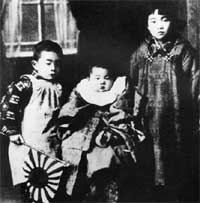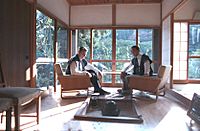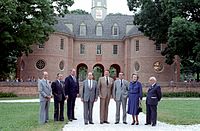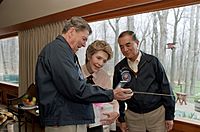Yasuhiro Nakasone facts for kids
Quick facts for kids
Yasuhiro Nakasone
Junior First Rank
|
|
|---|---|
|
中曽根康弘
|
|
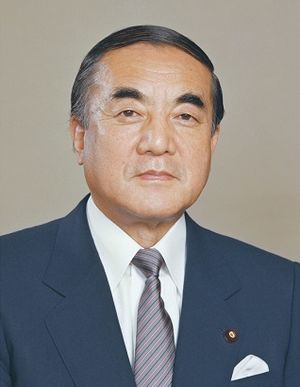 |
|
| Prime Minister of Japan | |
| In office 27 November 1982 – 6 November 1987 |
|
| Monarch | Shōwa |
| Deputy | Shin Kanemaru |
| Preceded by | Zenkō Suzuki |
| Succeeded by | Noboru Takeshita |
| Member of the House of Representatives | |
| In office 26 April 1947 – 10 October 2004 |
|
| Constituency | Gunma 3rd district (1947–1996) Northern Kanto PR (1996–2004) |
| Personal details | |
| Born | 27 May 1918 Takasaki, Gunma, Empire of Japan |
| Died | 29 November 2019 (aged 101) Tokyo, Japan |
| Political party | Liberal Democratic Party |
| Spouse |
Tsutako Nakasone
(m. 1945; died 2012) |
| Children | Hirofumi Nakasone |
| Alma mater | Tokyo Imperial University |
| Signature |  |
| Military service | |
| Allegiance | |
| Branch/service | |
| Years of service | 1941–1945 |
| Rank | Lieutenant-commander (as Naval Paymaster) |
| Battles/wars | World War II |
Yasuhiro Nakasone (中曽根 康弘, Nakasone Yasuhiro, 27 May 1918 – 29 November 2019) was an important Japanese politician. He served as the Prime Minister of Japan and the leader of the Liberal Democratic Party from 1982 to 1987. He was also a member of Japan's Parliament, called the House of Representatives, for over 50 years. He was known for making government-owned companies private and for his strong support of the United States.
Contents
Early Life and Education
Yasuhiro Nakasone was born in Takasaki, Gunma Prefecture, Japan, on May 27, 1918. His father, Matsugoro II, was a lumber dealer. The Nakasone family had a history as samurai warriors during the Edo period.
Nakasone described his childhood as happy. He was a quiet child who later became an excellent student. He studied history and literature in high school and learned to speak French. In 1938, he went to Tokyo Imperial University.
During World War II, Nakasone served in the Imperial Japanese Navy. He was a commissioned officer and a paymaster. He was stationed in Indonesia to help build an airfield. After Japan surrendered in 1945, he returned to Tokyo. He saw the city in ruins and promised himself to help rebuild his homeland.

Early Political Career
In 1947, Nakasone decided to enter politics. He believed Japan needed to keep its traditional values after the war. He ran for Parliament, focusing on nationalist ideas. He wanted a stronger Self-Defence Force and to change Article 9 of the Japanese Constitution, which said Japan could not use war to settle international problems. He also wanted to bring back Japanese patriotism.
He became a member of the Diet of Japan (Japan's parliament) for the Democratic Party. In 1951, he bravely wrote a letter to General Douglas MacArthur, who was in charge of the Allied occupation of Japan. Nakasone criticized the occupation, which made him known as a right-wing politician.
Nakasone moved up in the LDP. He became the Minister of Science in 1959. Later, he served as Minister of Transport in 1967 and the head of the Japan Defense Agency from 1970 to 1971. He also held roles as Minister of International Trade and Industry and Minister of Administration. As head of the Self-Defence Force, he wanted to increase Japan's defense spending.
Prime Minister of Japan
In 1982, Yasuhiro Nakasone became the Prime Minister of Japan. During his time, he worked to improve Japan's relationships with other countries.
Foreign Relations
Nakasone worked with Foreign Minister Shintaro Abe to improve ties with the USSR and People's Republic of China. He was very well known for his close friendship with U.S. President Ronald Reagan. People often called their friendship "Ron-Yasu." Nakasone wanted Japan and the U.S. to have a more equal relationship. He famously said, "President Reagan is the pitcher and I'm the catcher." He meant that he would work closely with Reagan.
Nakasone also said Japan would be "America's unsinkable aircraft carrier" in the Pacific. This meant Japan would help protect the region and control important sea routes. Some of his political opponents criticized him, calling him a "dangerous militarist." However, Nakasone believed Japan should be proud and move forward. He tried to change Article 9 of the Constitution, but he was not successful.
In 1984, Nakasone visited China. The Chinese government arranged for 3,000 Japanese young people to visit China, which helped build friendly relations. He also visited President Corazon Aquino in the Philippines to strengthen economic and trade ties.
Economic Changes
One of Nakasone's most important policies was to make state-owned companies private. This meant the government sold these companies to private owners.
- He broke up Japan National Railways into the modern Japan Railways Group (JR). This change led to many job reductions, which was new for Japan at the time.
- He also privatized Nippon Telegraph and Telephone Public Corporation, creating Nippon Telegraph and Telephone Corporation (NTT).
- Japan Tobacco and Salt Public Corporation became Japan Tobacco Inc. (JT).
These changes helped reduce the number of employees in these companies. They also greatly improved their income, productivity, and sales. For example, after privatization, NTT, JT, and JR saw their income and sales increase significantly.
Nakasone also wanted to change Japan's economy to rely less on exports. In 1985, he set up a group led by Haruo Maekawa to study Japan's economic future. The group suggested that Japan should grow from within, not just by selling goods to other countries. Nakasone even publicly bought foreign goods, like an American tennis racket, to encourage Japanese people to do the same. He said Japan was like a "mah-jong player who always wins," meaning other countries might stop playing if Japan always won in trade.
Cultural and Educational Policies
Nakasone also had strong nationalist views. He believed Japan was unique compared to other parts of the world. He thought Japan's "monsoon culture" made Japanese people especially compassionate.
In 1985, on the 40th anniversary of Japan's surrender in World War II, Nakasone and his Cabinet visited the Yasukuni Shrine. This shrine honors Japan's war dead, including some convicted war criminals. His visit was controversial. The Chinese government criticized it, and some people in Japan said it went against the separation of religion and state. Nakasone defended his visit, saying it showed respect for ancestors.
Nakasone also wanted to reform education. He set up a commission that suggested teaching children "a spirit of patriotism" and respect for elders. It also recommended teaching the national anthem and raising the Rising Sun Flag at school ceremonies. History textbooks were also updated.
In 1987, Nakasone had to resign. This happened after he tried to introduce a new tax called a value added tax to help reduce the government's debt.
-
Having lunch with Ronald Reagan (at Nakasone's country residence in Hinode, Nishitama, Tokyo in 1983)
-
With leaders of the G7 (at the 9th G7 summit in 1983)
-
With Ronald Reagan (at Camp David on 13 April 1986)
-
With Ronald Reagan and Nancy Reagan (at Camp David on 13 April 1986)
Later Political Life
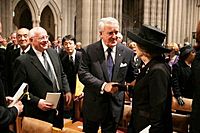
After leaving the prime minister's office, Nakasone was replaced by Noboru Takeshita in 1987. He was later involved in a political scandal called the Recruit scandal.
Even though he stayed in Parliament for another 15 years, his influence slowly decreased. In 2003, the LDP introduced an age limit for candidates, which ended his career as a member of the Diet.
In 2010, Nakasone was seen as a respected elder statesman in Japan. He gave interviews to share his thoughts on the government's direction. He believed that having a strong second political party was a step towards true democracy. He also stressed the importance of Japan's close relationship with the United States.
Personal Life and Death
Yasuhiro Nakasone married Tsutako Nakasone on February 11, 1945. She passed away in 2012. Their son, Hirofumi Nakasone, is also a member of the Diet and has served as Minister of Education and Minister of Foreign Affairs.
Nakasone lived to be very old, turning 100 on his birthday. He passed away in Tokyo on November 29, 2019, at the age of 101 years. He was the second oldest Prime Minister of Japan.
Honours
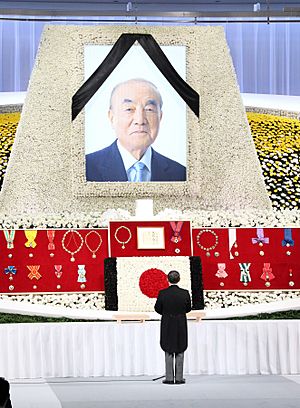
National Honours
- Order of the Chrysanthemum :
Foreign Honours
 Mexico:
Mexico:
 Germany:
Germany:
 Philippines:
Philippines:
 Egypt:
Egypt:
 Indonesia:
Indonesia:
 Star of Mahaputera, 1st Class (Indonesian: Bintang Mahaputera Adipurna)
Star of Mahaputera, 1st Class (Indonesian: Bintang Mahaputera Adipurna)
 Norway:
Norway:
 Argentina:
Argentina:
 Brunei:
Brunei:
 Peru:
Peru:
 Grand Cross of the Order of Merit for Distinguished Service (Spanish: Orden al Mérito por Servicios Distinguidos)
Grand Cross of the Order of Merit for Distinguished Service (Spanish: Orden al Mérito por Servicios Distinguidos)
 Finland:
Finland:
 South Korea:
South Korea:
 Thailand:
Thailand:
 France:
France:
See also
 In Spanish: Yasuhiro Nakasone para niños
In Spanish: Yasuhiro Nakasone para niños
Offices and Distinctions


